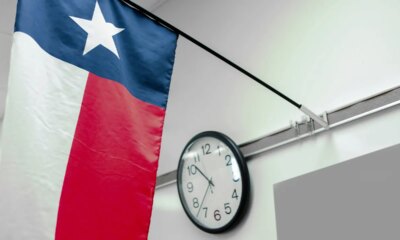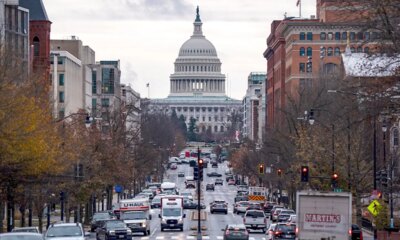Sports
Ex-Saints player Steve Gleason stable after being moved to hospital as Hurricane Francine made landfall

Former New Orleans Saints safety Steve Gleason, who is battling ALS, was stable after he was forced to move to a hospital as Hurricane Francine barreled down on Louisiana.
Gleason’s family wrote in a post on his X account on Thursday that he had been moved to Ochsner Medical Center with help from the New Orleans Fire Department.
Oct. 6, 2019; New Orleans, LA: New Orleans Saints former safety Steve Gleason watches the Saints play the Tampa Bay Buccaneers in the first quarter at the Mercedes-Benz Superdome. (Chuck Cook-USA TODAY Sports)
“For those who have asked, Steve was taken to Ochsner last night during the storm. He is now stable. We want to thank @NOLAFireDept first responders and @NewOrleansEMS for getting to us during unsafe circumstances and to the @OchsnerHealth staff for their immediate care,” the post read. “We will update everyone as soon as we know more. Thanks, the Gleason Crew.”
Gleason’s publicist Clare Durrett told ESPN that the player was suffering from a fever and had extremely low blood pressure and that his doctor had suggested that he be taken to a hospital. However, Francine was a Category 2 hurricane heading toward the state.
“They immediately stabilized him and transported him to Ochsner,” Durrett told the outlet. “He remains there and stable. He’s continuing to be treated, and we are hopeful Steve will do what Steve does and warrior through to get home as quickly as possible.”
CHIEFS WIDE RECEIVER MARQUISE BROWN TO HAVE SHOULDER SURGERY, GO ON IR
Oct 19, 2023; New Orleans, Louisiana, USA; Former New Orleans Saints player Steve Gleason wears a halloween costume before a game between the New Orleans Saints and the Jacksonville Jaguars at the Caesars Superdome. Because Gleason uses a breathing tube, he can be wrapped with cellophane covering his mouth. (Matthew Hinton-USA Today Sports)
Gleason’s family then posted an update from the former player on Friday.
“ALS is a hurricane of a disease, and on 9/11 in the midst of Hurricane Francine, power outages, & sketchy phone service, hurricane ALS made landfall.
“Thank you for the powerful love and support from all of you.
“Celebrate this change to be alive and breathing.”
Gleason played seven seasons with the Saints from 2000 to 2006 and had 71 total tackles in 83 games.
October 23, 2005; St. Louis, MO: New Orleans Saints Steve Gleason is called for pass interference against St. Louis Rams Kevin Curtis (83) in the first quarter at the Edward Jones Dome. (Scott Rovak-USA TODAY Sports)
He revealed in 2011 that he was battling ALS. He was awarded a Congressional Gold Medal in 2019 and the Arthur Ashe Courage Award earlier this year.
Follow Fox News Digital’s sports coverage on X, and subscribe to the Fox News Sports Huddle newsletter.

Sports
Teenage MLB prospect Frank Cairone hospitalized after car crash

NEWYou can now listen to Fox News articles!
Top Milwaukee Brewers prospect Frank Cairone was hospitalized after being involved in a serious car accident near his New Jersey home on Friday, the team announced.
“Frank is currently being cared for at a hospital in New Jersey with the support of his family,” read a statement from the team, via MLB.com. “The Brewers’ thoughts and prayers are with Frank and his family during his difficult time.”
Pitcher Frank Cairone (left) with Green Valley High School (NV) infielder Caden Kirby during the MLB Draft Combine high school baseball game at Chase Field. (Mark J. Rebilas/Imagn Images)
The left-handed pitcher turned 18 this past September. He was drafted out of Delsea Regional High School in Franklinville, N.J. at No. 68 overall in the 2025 Draft.
News of the Brewers’ young prospect’s accident came shortly after the team announced it was not in contact with several players in Venezuela after U.S. military strikes in the country and the capture of its President Nicolás Maduro.
MLB TEAM UNAWARE OF STATUS OF PLAYERS IN VENEZUELA AFTER US MILITARY STRIKES
Milwaukee Brewers outfielder Jackson Chourio (11) is seen before the fifth inning of an MLB game between the Milwaukee Brewers and the Toronto Blue Jays on August 31, 2025, at Rogers Centre in Toronto, ON. (Mathew Tsang/Icon Sportswire via Getty Images)
Brewers president of baseball operations Matt Arnold revealed the team is unaware of the status of the players in a statement Saturday.
“We don’t have much info at the moment but are trying to follow up,” Arnold said, via the Milwaukee Journal Sentinel. “We know the airports have been shut down but not much beyond that.”
CLICK HERE TO DOWNLOAD THE FOX NEWS APP
Pitcher Frank Cairone during the MLB Draft Combine high school baseball game at Chase Field. (Mark J. Rebilas/Imagn Images)
The team’s players in Venezuela include star outfielder Jackson Chourio, infielder Andruw Monasterio and catcher Jeferson Quero, according to the outlet.
Follow Fox News Digital’s sports coverage on X, and subscribe to the Fox News Sports Huddle newsletter.
Sports
City Section boys’ basketball has nowhere to go but up after hitting rock bottom

It might be time to write a folk song about the demise of City Section basketball using the music of Peter, Paul and Mary and the new title, “Where Have All the Players Gone?”
The talent level clearly has hit rock bottom only a year after Alijah Arenas was a McDonald’s All-American at Chatsworth High and Tajh Ariza led Westchester to the City Section Open Division title. Because their parents went to City Section schools, Arenas and Ariza stuck it out. Then Arenas graduated early to join USC and Ariza left for St. John Bosco, then prep school.
Westchester is where Ed Azzam won 15 City titles in 42 seasons until his retirement in 2021. Crenshaw is where Willie West won 16 City titles and eight state titles. Taft is where Derrick Taylor won four City titles and coached future NBA players Jordan Farmar, Larry Drew II and AJ Johnson. Fairfax is where Harvey Kitani coached for 35 years, won four City titles and two state titles and earned most of his nearly 1,000 victories. He was followed by Steve Baik and Reggie Morris Jr., each of whom won City championships before leaving.
None of the City schools once considered among the best in Southern California are even close to resembling their glory days, and they aren’t alone. The City Section has lost most of its talent, and it was truly Hall of Fame talent: Marques Johnson and John Williams at Crenshaw; Gail Goodrich at Sun Valley Poly; Willie Naulls at San Pedro; Dwayne Polee at Manual Arts; Gilbert Arenas at Grant; Trevor Ariza at Westchester; Chris Mills at Fairfax. There were decades of success.
There’s no one person to blame. You can’t even place the downfall solely on the Los Angeles Unified School District, whose high schools compete in the City Section.
But LAUSD has done nothing to reverse the trend and didn’t help matters by opening so many new schools in such rapid fashion that longtime legacy schools lost their luster amid declining student enrollment. Things became even more disruptive by the rise of charter schools and private schools taking away top athletes. Adding to that, the loss of veteran coaches frustrated by bureaucracy issues and rules that force programs to secure permits and pay to use their own gyms in the offseason helped further the exodus.
Westchester is 2-8 this season and an example of where City Section basketball stands. Two top players from last season — Gary Ferguson and Jordan Ballard — are now at St. Bernard. Westchester doesn’t even have a roster posted on MaxPreps. King/Drew won its first City Open Division title in 2024 under coach Lloyd Webster. This season Webster sent his senior son, Josahn, to Rolling Hills Prep to play for Kitani. King/Drew is 4-10.
Charter schools Birmingham, Palisades and Granada Hills have separated themselves in virtually all City Section sports including basketball. They have no enrollment boundaries as long as there’s a seat for a student. Palisades lost so many students after the wildfire last year that transfers have been big additions for its teams this school year. Online courses are being offered to help students enroll and compete in sports at charter schools.
The old powers from the inner city — Crenshaw, Dorsey, Jefferson, Locke and Fremont — experienced big changes in demographics. Many coaches are walk-ons and not teachers. The legacy schools have to compete with charter schools View Park Prep, Triumph, Animo Watts, Animo Robinson, WISH Academy and USC-MAE. When young players are discovered and developed, rarely will they stay when one of the private schools or AAU coaches searching for talent spots them in the offseason.
So what’s left? Not much.
Palisades, Washington Prep and Cleveland look like the three top teams this season. All three added transfers to help buck the downward trend. And yet their records are 3-10, 8-8 and 7-6, respectively, against mostly Southern Section teams.
Maybe this can be a fluke one-year plunge to the bottom and the climb back up can begin, aided by coaches who recognize their job is to teach lessons in basketball, life and college preparation. Parents need a reason to send their kids to a City Section school. It’s up to LAUSD and principals to help change the trajectory by finding coaches with integrity, passion and willingness to embrace the underdog role.
There are plenty in the system doing their best. It’s time to start hearing and answering their pleas for help.
Sports
Seahawks secure top seed in NFC with dominant road win over 49ers

NEWYou can now listen to Fox News articles!
The Seattle Seahawks locked down the top seed in the NFC playoffs and a strong path to the Super Bowl on Saturday night with a season finale win over the San Francisco 49ers.
Seattle also finished with their best regular season record in franchise history, clinching 14 wins for the first time ever.
The Seahawks held on to a 10-point victory despite outgaining the 49ers 363 yards to 173, and running 64 plays to San Francisco’s 42.
Jaxon Smith-Njigba #11 of the Seattle Seahawks fails to catch the ball against Ji’Ayir Brown #27 of the San Francisco 49ers during an NFL game on Jan. 3, 2026 at Levi’s Stadium in Santa Clara, California. (Matthew Huang/Icon Sportswire)
Seattle missed a field goal in the fourth quarter and turned the ball over on downs in the first quarter to waste two red zone drives, but dominated on defense to prevent those missed opportunities from coming back to haunt them.
The 49ers wasted their best drive of the night as well when quarterback Brock Purdy was intercepted at Seattle’s three-yard line in the fourth quarter facing a 10-point deficit, which seemingly secured the game for the Seahawks.
NFL WEEK 17 SCORES: AFC NORTH, NFC SOUTH UP FOR GRABS AS PLAYOFF PICTURE ALMOST COMPLETE
Seahawks quarterback Sam Darnold, in his first season on the team, completed 20 passes on 26 attempts for 198 yards and helped set up the only touchdown of the entire game in the first quarter.
Darnold redeemed a disappointing Week-18 game for the Minnesota Vikings last season when he completed just 18 of 41 passes for 166 yards in a battle for the top seed against the Detroit Lions.
Darnold said “Learning from mistakes, and staying calm from the pocket,” made the difference in his performance Saturday compared to a year ago, in a postgame interview with ESPN.
CLICK HERE TO DOWNLOAD THE FOX NEWS APP
Jaxon Smith-Njigba #11 of the Seattle Seahawks carries the ball against the San Francisco 49ers during the second quarter of a game at Levi’s Stadium on January 03, 2026 in Santa Clara, California. (Ezra Shaw/Getty Images)
Meanwhile, 49ers quarterback Brock Purdy had just 127 yards with the late interception, and took a big hit on his final pass of the night, then took a while to get back up. He was eventually able to walk off the field, and Seattle ran the clock out.
Follow Fox News Digital’s sports coverage on X, and subscribe to the Fox News Sports Huddle newsletter.
-

 World1 week ago
World1 week agoHamas builds new terror regime in Gaza, recruiting teens amid problematic election
-

 Indianapolis, IN1 week ago
Indianapolis, IN1 week agoIndianapolis Colts playoffs: Updated elimination scenario, AFC standings, playoff picture for Week 17
-

 Business1 week ago
Business1 week agoGoogle is at last letting users swap out embarrassing Gmail addresses without losing their data
-

 Southeast1 week ago
Southeast1 week agoTwo attorneys vanish during Florida fishing trip as ‘heartbroken’ wife pleads for help finding them
-

 World1 week ago
World1 week agoSnoop Dogg, Lainey Wilson, Huntr/x and Andrea Bocelli Deliver Christmas-Themed Halftime Show for Netflix’s NFL Lions-Vikings Telecast
-

 Politics1 week ago
Politics1 week agoMost shocking examples of Chinese espionage uncovered by the US this year: ‘Just the tip of the iceberg’
-

 News1 week ago
News1 week agoRoads could remain slick, icy Saturday morning in Philadelphia area, tracking another storm on the way
-

 World1 week ago
World1 week agoPodcast: The 2025 EU-US relationship explained simply


















